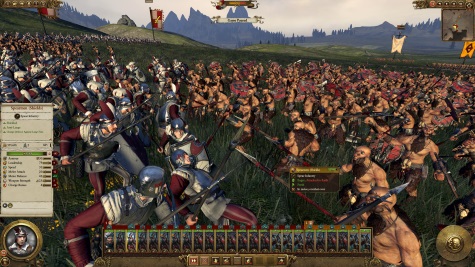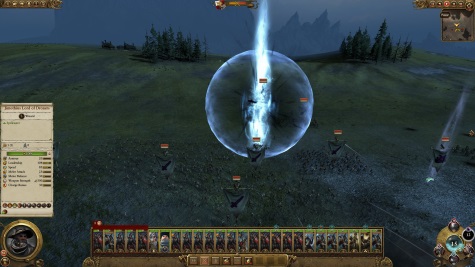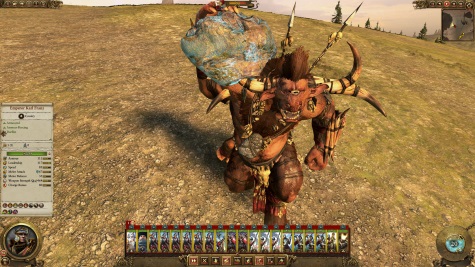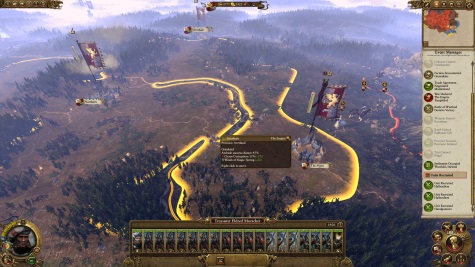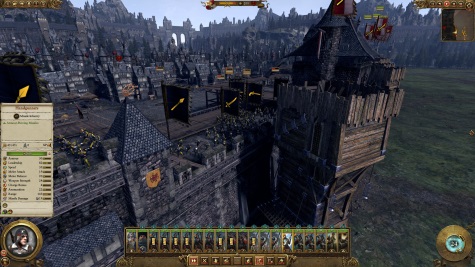So obviously people are already playing the sequel but I’ve only just got around to playing this first title despite having owned it for a while. To tell the truth, I was rather surprised by how quickly the next one came out since this one was only released last year. Apparently it’s more of a standalone expansion than a sequel so playing this one right now is still okay. I had held off on playing this for so long because I’m still feeling burned out on the Total War formula. Back in the heyday I was one of those who thought that this property was a natural fit for this style of video game but now that it’s here I find that even the pausable real-time gameplay is a bit much for me.
I’m not terribly familiar with Warhammer Fantasy lore but as I understand it this game takes place on a map of the Old World that is essentially a single large continent. Though there are a few places where you need to cross water, such as in the far north to get to Norsca, this means that there is no need for ships and so there is no naval warfare component. Roughly speaking, the map puts the elves in west, the dwarves and the orcs in the south, the forces of Chaos in the north and the humans in the middle, with the vampires in the southeast corner of the human area. What’s especially cool is that each faction has mechanics that are unique to it. Both Chaos and the Vampires have a corruption effect that cause attrition to normal units that move through their lands, the dwarves have a grudge system that requires them to pay back slights done to them while the Empire has the more boring option of appointing their leaders to offices.
Since we’re now in the realm of fantasy it’s only to be expected that the differences between the various unit types are much greater than they were in any previous Total War game. Flying units are so fast and so maneuverable that I found it impossible to prevent them from savaging my missile and artillery units no matter how hard I tried to guard them. The Beastmen use Cygors as artillery, which are so powerful that engaging them in melee with regular infantry is rather dangerous. Heck, the Empire has literal tanks that are happy to be in melee range of enemies. Then there are the magic spells and special abilities available to leaders and heroes. There are buffing spells, bombardment spells, debuffs and even healing effects. As you might expect, it’s a lot more chaotic than the Total War games I was used to and much more micro-management heavy.
This fact plus how the auto-resolve option generally gives rather good results caused me to avoid manually fighting something like ninety percent of the battles. Doing so basically turns this into a turn-based strategy game which it is decent at but would be decidedly missing the point of the series. From what I can tell plenty of people do enjoy the battles so it’s probably mostly me. If I were younger perhaps I could get more into it but right now I find that I’m annoyed by the chaos and how organized formations don’t work any more. To do well, you need to use the correct units to chase down the appropriate enemy units and that results in your army being a total mess. It’s also rather important to lock down enemy leaders and heroes who can be difficult to handle unless tackled with a hero of your own.
Still even if I found it hard to get into the spirit of things, I still admire many aspects of the design. The fact that units and factions can differ so much from one another results in all kinds of interesting effects. The dwarves for example are stout, tough and almost unbreakable. However they have no cavalry whatsoever making it almost impossible to chase down routing enemy units to whittle down their numbers and no access to magic. Their movement speed on the strategic map is also lower than average but they make up for that with the underway movement mode that bypasses terrain obstacles and makes them immune to corruption. Pretty neat package all around. The Empire has lacklustre infantry but the best cavalry in the whole game and an incredible array of magical might. They have to carefully slog through corruption being mindful of the attrition effects but their buildings and heroes offer lots of ways to beat back corruption. Likewise the Orcs have the WAAAGH!, the Vampires can raise the dead and so forth. It’s all quite impressive.
What I like less is that using heroes as agents on the strategic map is once again very micro-management heavy and the AI seems to recruit so many of them that they’re very annoying. I also don’t think the way the game tries to include story battles works very well. The story battles seem to be meant to give your faction leader powerful bonuses provided you complete the quests and as usual with such things the fact that these quests are set in stone mean that they often don’t fit in with what actually happens in the game. For example, my dwarves had to fight a story battle against vampires but that was well after the faction had been completely wiped due both to my efforts to raze every one of their settlements and to the ongoing Chaos invasions.
I found the game somewhat harder than expected, not because the AI is smart but because of how enemies are scripted to appear out of nowhere to attack your settlements. The Chaos stacks are no joke though I had a hoot watching them wipe out the Empire cities while playing as the dwarves. Similarly as the dwarves I saw a new faction sail towards my coastal areas to ravage my interior with no warning. Despite completely wiping them out, new stacks of orcs also appear at scripted moments. They’re easy enough to beat if you happen to have an army stationed nearby but to do you need to know in advance where they will appear. Plus of course there’s a huge difference in difficulty that depends on your faction, not because of their advantages and drawbacks but because of their geographical position.
Overall I did find this to be an excellent adaptation of the Warhammer material into the Total War formula. The fact that I couldn’t really get into it is more about me than about the game. I found the real-time battle to be too much of a hassle to be truly enjoyable and without that component the turn-based strategy layer is merely average. I actually found myself wishing that I was playing a good turn-based strategy game instead. So yeah, I won’t be around for the sequel but best of luck to Creative Assembly anyway.
